Rediscovery and Restoration: abstract mural by Joseph Rugolo created for the WPA in the 1930s
Under the Surface
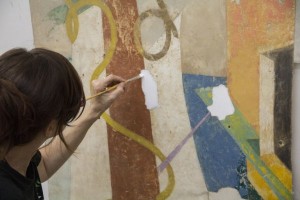
A conservator performing inpainting on a WPA-commissioned mural by Joseph Rugolo.
Featured Images: (Click to Enlarge)
A resourceful art doctor, it turns out, must possess skill in sleuthing. Before the Goldwater Memorial Hospital on Roosevelt Island—a two-mile-long dagger’s blade anchored in the East River that for most New Yorkers functions as little more than the underpass of the Queensboro Bridge—was demolished last year, the city’s Art Commission insisted that the new owner of the site, Cornell University, execute a search for two murals entombed somewhere in the hospital’s walls.
The murals—one painted by Albert Swinden, the other by Joseph Rugolo—were commissioned by the Works Progress Administration and for that reason, in part, were forgotten for decades. The WPA contracted thousands of artists to help integrate art into public spaces between 1935 and 1943, but the creative boom years were in many cases followed by neglect, either due to a lack of funding for upkeep or a blunted sense of appreciation. No more than 15 years after they were pasted to the hospital’s plaster walls in 1942, the murals by Swinden and Rugolo, as well as another piece by Ilya Bolotowsky (which was uncovered in 2001 and also later removed), were painted over. Dane Chanase was also asked to produce a mural for the hospital, though it is unclear if his piece was ever installed.
Though less known than heavy hitters of the WPA era such as Jackson Pollock and Mark Rothko, the trio of artists who adorned the hospital were forerunners in abstract mural painting. Swinden, an English immigrant, and Bolotowsky, who came from Russia, were both students of the Neoplasticist movement and founders of American Abstract Artists, a collective formed in 1936 to foster discussion of abstract art. The WPA-commissioned murals that Swinden and Bolotowsky each painted for the Williamsburg Housing Project that year were the first abstract murals authorized under the program and are now on loan to the Brooklyn Museum. Rugolo’s 1938 Mural of Sports, commissioned by the WPA for New York’s Roosevelt High School, is owned by the Newark Museum and is seen as an early call for equality in sports. The prominent figure in the mural is Jesse Owens, the winner of four gold medals at the 1936 Olympic Games in Berlin.
When Gillian Randell, a conservator with the restoration firm EverGreene Architectural Arts, began a hunt for the Swinden and Rugolo murals in June 2013, the clues that existed about them weren’t much to go on. The pieces were done in oil paint on canvas sheets 50 feet long and 7 feet high. Only the hospital’s 32 convex day rooms had wall space enough for pieces that large, but the original floor plan of the facility wasn’t much help because room numbers had changed.
The Art Commission provided Randell some early photographs of the murals, though no reliable color palette could be discerned. The murals’ rare abstract composition was the primary reason for recovery, but also complicated every unknown. “There are very few abstract or more modern compositions,” says Randell. “You get really monumental human figures, like at Rockefeller Center—those kind of 20th-century American, nationalistic history paintings. The Bolotowsky, Swinden and Rugolo, they’re really the only extant more modern WPA murals that survived.”
The key question bugging Randell: Once she came across the murals, how would she know for sure? Conservation is an inexact science, to begin with, and conservators are improvisers by default. They aren’t precisely certain what is required of a project until it begins, and even then, no plan extends too far ahead. But in the case of these murals, a swath uncovered after dissolving and scraping away six layers of paint would not immediately reveal itself as a work of art. “Because these are abstract pieces, layers of color don’t necessarily make sense,” Randell says. “It’s not like you would find a bird, for instance.”
What was required of Randell, first and foremost, was earnest detective work. After nearly a year, she had inspected every day room with an archaeologist’s patience and a doctor’s steady hand. She used chemical solutions to erode the house paint caked on the walls layer by layer, then scraped it away with a surgical scalpel to crack open a tiny exposure window. This methodical examination was occasionally performed between the hours of midnight and 4 a.m., because some of the day rooms were still in use by the hospital’s last remaining patients. (Those graveyard shifts required a dose of fortitude, considering the old hospital was once a filming location for “The Exorcist” due to its eerie after-dark atmosphere.) Eventually, a sliver of canvas poked through the house paint on the third floor of the hospital’s B wing. It was the Rugolo. One floor up in the same wing, underneath a sterile white wall mounted with a cork board and Purell dispenser, Randell found the Swinden. “We knew they were here somewhere,” says Jeff Greene, the president and founder of EverGreene. “It was due diligence, really, before tearing the building down. But it was definitely a search for hidden treasure.”
Last April, the 15-person team from EverGreene assigned to restoring the murals began the deliberate process of removing each piece. The canvases had been mounted on plaster walls using a stubborn and highly toxic lead-based adhesive. Crew members relied on an offbeat combination of hazmat suits with respirators and pastry knives to carefully pry the canvases from the wall. First, a corner came loose. Then, moving a few feet each day, the murals—still concealed by a 1/16-inch thick layer of over-paint—were rolled onto large tubes and transported to EverGreene’s headquarters near the mouth of the Lincoln Tunnel as demolition crews closed in on the hospital. “We didn’t have a moment to spare,” says Sarah Kloze, the project’s manager.
EverGreene fashioned a containment room on the sixth floor, so as to trap the toxic particles the moon-suited conservators flicked off the canvases. To remove the over-paint—the top layers were acrylic, but closer to the canvas stronger, oil-based paints had been applied—varied techniques, conventional and kooky, were employed. In some spots, a scalpel did the trick. In others, a heat gun or a chemical solution was necessary. “We mimicked the healing arts,” Randell says. “More than once, someone said, ‘You’re an art doctor.’”
The design of the murals began to emerge, a soothing and beautiful mixture of colors. Both pieces play off the presence of the East River, which was visible through the windows of the day rooms, and draw upon the peacefulness and kinetic energy of water. The Swinden piece seems to glide forward as you scan the gray lines, golden blocks and deep blue swirls that intersect over its span. Each cluster of shapes is headed in unison, lazily, toward another destination. Rugolo’s mural captures water more directly. His vibrant color palette—aqua and periwinkle blues, gentle yellows and vibrant reds—bring to mind a summer afternoon at the beach. A red flag ripples in the wind, and a sail flaps. Slender loops of color are birds diving towards a sea of blue or pointed skyward. A shark pokes its head above water to bask in the sun.
The future of these murals is yet unknown, but Randell says the condition of the canvases is encouraging, considering “all they’ve been through.” Perhaps Cornell Tech, which will rise on the Goldwater site and house the Bolotowsky mural, will find a place for the other two, as well. The decades of neglect have unexpectedly infused the reborn murals with new spirit. There is a finish on each mural, the remnant of sun damage, a little too much washing and a topcoat of oil paint that provides each piece with a dignified, well-worn tone. “They have a personality, a character to them, even in this state. It is part of what makes them interesting is their history and this patina. Maybe if they were pristine they would be less interesting,” Greene says. “I know artists who would die to be able to create those textures.”
By Michael Fensom
 |
| A detail of the conserved Rugolo mural |
Goldwater Memorial Hospital Murals
EverGreene investigated the possible existences of two WPA artworks, by artists Joseph Rugolo and Albert Swinden, originally commissioned for Goldwater Memorial Hospital. Conservators confirmed the location of the murals, assessed their conditions, then safely removed and conserved the historic murals.
Once removed from the site, conservation began at EverGreene’s plaster studio, which had been converted into a negative-air chamber and lead-containment zone. Conservators used both chemical strippers and hand tools to painstakingly remove the overpaint from the historic murals: scalpels and small blades proved most useful in the removal of certain areas of overpaint from the Swinden murals, while heat guns and wooden sculpting tools were effective in revealing the Rugolo artwork.
Once the overpaint was removed, conservators began carefully inpainting areas of complete loss or damage to match the exisiting mural. Conservation paints were used to match the historic color palette of the artworks. The murals are currently awaiting relocation within the new Cornell Tech campus.
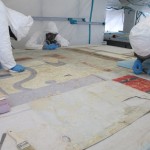
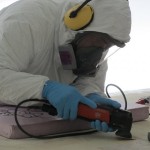
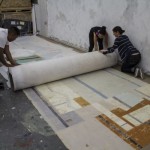
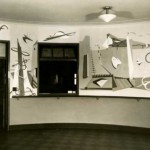
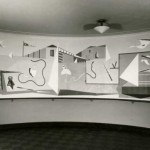
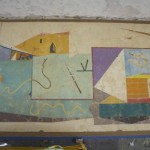
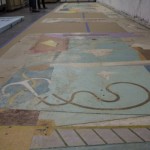
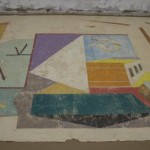
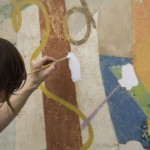
Comments
Post a Comment